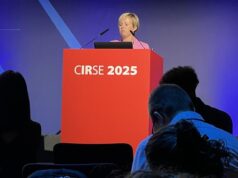
As presented at the Global Embolization Oncology Symposium Technologies (GEST) 2020 meeting (4–6 September, virtual), Robert Lewandowski discusses the evolution of radioembolization with Yttrium-90 (Y-90) over the past decade. Initially a lobar therapy, Y-90 can today be performed via a segmental delivery of microspheres to hepatocellular carcinoma (HCC) patients at earlier stages in their disease, and multiple tumours can be targeted in a same-day session. Furthermore, Lewandowski recounts how threshold dosimetry is now allowing for curative-intent therapy, and explains that the most recent data suggest this personalised dosimetry approach can be applied to a more advanced HCC population.
The historical role of radioembolization with Y-90 for patients with HCC is in the salvage setting; radioembolization has been employed to treat patients considered poor candidates for trans-arterial chemoembolization (TACE) or those that failed TACE. In contradistinction to the selective approach of TACE, radioembolization has been performed in a lobar (or sequential lobar) fashion. Despite these differences in patient selection and technique, evidence has supported the application of radioembolization over TACE in intermediate staged HCC patients because of improved quality of life metrics and longer time to progression. The median overall survival (OS) for patients with intermediate-stage HCC treated with Y-90 is 25 months.
A serendipitous observation following uni-lobar radioembolization was the development of an atrophy-hypertrophy complex; the treated hepatic lobe and targeted tumour decrease in size, with resultant hypertrophy in the contralateral lobe. For patients who would be candidates for surgical resection but present with an inadequate future liver remnant (FLR), radiation lobectomy was developed as a new paradigm to facilitate hepatic resection. With standard dosimetry, FLR hypertrophy is a time-dependent process with approximately 10% hypertrophy from baseline at one-month post Y-90, and 45% by nine-months post Y-90. More recently, modified radiation lobectomy techniques have been developed to increase the rate of hypertrophy and to deliver more effective cancer therapy.
The application of radioembolization is evolving from its lobar therapy origins; radioembolization is increasingly utilised in a segmental fashion to treat earlier stage disease. The results of the PREMIERE trial, a prospective, randomised trial for patients with unresectable tumours not amendable to ablation, revealed significantly improved outcomes for segmental radioembolization versus segmental TACE (time-to-progression >26 months vs. 6.8 months, respectively). These results have been corroborated by other US sites, including the University of Washington in Seattle, Mt Sinai Hospital in New York City, and the Mayo Clinic in Jacksonville. The true potential of segmental radioembolization, however, is in its ablative potential. Radiology-pathology correlative studies have revealed that complete pathologic necrosis at explant is best obtained when the volumes of perfusion are targeted with glass microsphere dosimetry >190 Gray. A recent multi-centre analysis has reset this threshold dose for segmental radioembolization. In this analysis, all tumours treated with a segmental radiation dose >400 Gray achieved complete pathologic necrosis at explant.
High tumour response rates on imaging, long time to tumour progression, and meaningful complete pathologic response rates have made radiation segmentectomy a versatile therapy, allowing for down-staging to liver transplant, bridging to liver transplant, or as a potentially definitive curative-intent therapy for early stage HCC. Median overall survival outcomes for Child-Pugh A patients with solitary HCC <5cm appear consistent with those for other curative therapies (i.e., ablation, surgical resection, liver transplant): 6.7 years from date of Y-90.
The evolution of radioembolization from a lobar therapy to a segmental therapy includes technical modifications beyond threshold dosimetry to achieve complete pathologic necrosis. Many of these techniques have been developed for TACE over the past several decades. The first concept is that of same-day radioembolization: the planning angiogram, macro-aggregated albumin (MAA) administration to determine lung shunt fraction (LSF), and Y-90 administration can be performed in a single session. This is particularly appealing for patients with early stage disease amenable to radiation segmentectomy. Same-day radioembolization might further be streamlined by eliminating the requirement for the MAA administration in patients with limited disease burden. Recent data support this concept by confirming low LSF for those HCC patients within Milan criteria. The second concept is that of performing radioembolization to extra-hepatic tumour perfusing branches. There is no established optimal embolic device to treat tumours via parasitised extra-hepatic arteries; there are now published reports describing the delivery of Y-90 via the inferior phrenic arteries, the adrenal artery, and the cystic artery. The final concept is that of segmental administration of Y-90 to multi-focal disease. With segmental radioembolization, multi-focal disease can be targeted in a single session through separate selective arterial catheterisations and dose vial administrations.
In conclusion, radioembolization with Y-90 has evolved over the past 10 years, morphing from a lobar therapy for patients with HCC advanced beyond being amendable to TACE into a versatile treatment option for patients across the Barcelona Clinic Liver Cancer staging paradigm. This evolution has allowed for radioembolization to be performed in a similar fashion to TACE: segmental/selective delivery of Y-90 microspheres to HCC patients at earlier stages in their disease, targeting multiple tumours as well as extra-hepatic tumour-perfusing branches, often in a same-day session. Most importantly, threshold dosimetry is now allowing for curative-intent therapy, supported by explant data. This concept of threshold, or personalised, dosimetry has more recently been expanded and applied to the advanced HCC population (DOSISPHERE-01 TRIAL), accepted for publication in the Lancet Gastroenterology & Hepatology.
Robert J Lewandowski is a professor of Radiology, Medicine, and Surgery, and the director of Interventional Oncology at the Northwestern University Feinberg School of Medicine, Chicago, USA










